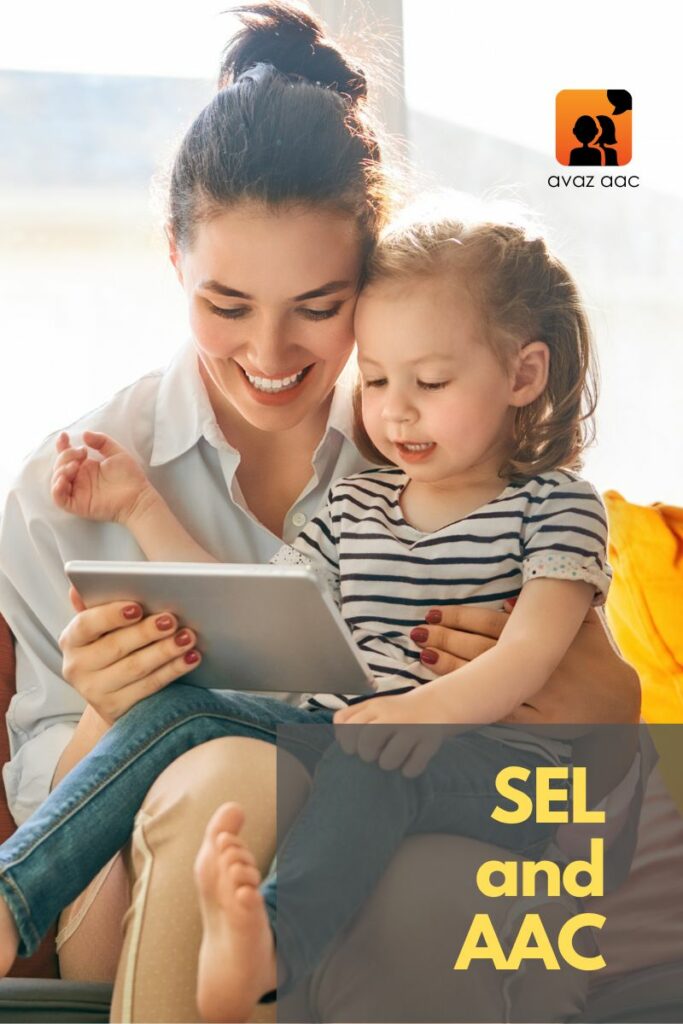This is the concluding article (Part 3) of our ongoing series on Social Emotional Learning. Avaz’s resident SLP, Niveditha, discusses SEL and AAC. She takes a closer look at how AAC can support Social Emotional Learning for students with complex communication needs.
You can read Part 1 of this series here. You can find Part 2 here.
Emotions & Social Interactions
Emotions play a key role in social interaction and communication The development of emotional competence underlies the development of other competencies. Additionally, it also impacts one‘s overall quality of life. People may react differently to the same stimulus. How individuals deal with emotions also varies widely. It is dependent on several factors, including social, cultural, familial experiences and more.
SEL Challenges for People with CCN
Socio-emotional competence is affected by the degree to which someone can access language / communication tools. Likewise, this also impacts how effectively they use it to interact and self-regulate.


Hence people with CCN or Complex Communication Needs may face many unique SEL challenges. These include:
- Difficulty with expression and / or comprehension of communication elements. This is especially true when they have multiple disabilities.
- Some individuals with special needs may have physical and cognitive limitations that may restrict Social and Emotional development.
- People misinterpret or ignore their emotional expressions.
- They have limited access to emotional language.
- They find it hard to find a good therapist: Often the focus of intervention is on Language and speech development and on using AAC‘ to reduce inappropriate behaviors. Therapists may lack knowledge/skills in the area of emotional competence. They may not have expertise/good strategies for understanding/ dealing with emotional issues.
Focus of AAC Rehabilitation in SEL: Current Trends
AAC intervention in SEL, currently, has its limitations. Here is how it happens in many places:
- Limited vocabulary: Communicators learn symbols of a very limited vocabulary. It is usually targeted. For instance, words describing basic emotions – happy, sad, angry.
- Training most often focuses on decreasing behavioral problems. The objective is to reduce or replace inappropriate behaviors.
- Functional Communication Training- Granted, this is very important and efficacious. That said, overt emphasis on this ignores sequence of emotional development. There is too little emphasis on providing ways to to self regulate emotions/ behavior
Having the functional skills to recognize, interpret, and respond constructively to emotions in oneself and others is essential for a successful life.( Griffiths & Scarantino (2009); Saarni (1999).
Intervention Ideas
How can we do a better job in incorporating SEL with AAC? Here are some ideas!
INPUT
The first step is to modify the input that we give to the learner / user.
- Start by labeling emotions.
- Model words (as they are happening) by using words/ symbols/ signs.
- Identify situations that cause an emotional response and then, talk about them.
- Try to talk about feelings in advance.
- Point to symbols on a display and use the child‘s device in natural settings.
- Talk to a child about their feelings and about another person’s emotions. While doing this, point to symbols or use signs. Help a child learn how their emotions might be the same or different from how a friend feels or behaves.
- Discuss narratives (stories, events etc.) to expand access to a range of more complex emotions. Thereafter, teach ways to express them.
OUTPUT
When the communication partner has modeled different emotions in different contexts, we can expect an output.
- Provide access to words that describe emotions and encourage their use.
- Move beyond happy, sad, angry. Do include words like confused, frustrated, hopeful, mad, disappointed – these are great vocabulary to expand on.
- Encourage emotional talk in natural settings.
- Accept and encourage use of multi-modal communication to express emotion.
- Provide opportunities to develop narratives that describe events, stories, and fantasy.
- Encourage role play/dramatic play to enact scenarios that depict situations with emotional content.
Intervention Ideas For Mature users
With consistent practice of above ideas, learners start becoming socially and emotionally mature. Here are some ideas to further expand on their SEL through AAC:
Talk about mixed emotions while modeling the symbols/words.
Adult-”By looking at your face I feel you are confused about the way you feel!! What do you think?”
Talk about hiding one’s emotions.
Sometimes it‘s not a great idea to hide how you are feeling.
“I thought you had every reason to be scared when you saw the dog running, but you just smiled. But now tell me How did you really feel?”
Build on developmental sequence of emotions across partners and settings
Acknowledge the need to develop interior dialogues.
Interior Dialogues are private communications that are potentially under the conscious control of the individual. We use them for a variety of functions. This includes – problem solving, venting feelings, self entertainment and processing the events of our daily lives
Children construct the type of inner world and inner communication that enables them to work through tough emotional situations. It helps them to develop emotional stability and coping mechanisms. It begins to emerge in preschool, but doesn‘t develop fully until later in childhood and beyond (Astington & Baird, 2005; Schneider, Lockl, & Fernandez, 2005).
All of us have interior dialogues in our day to day lives. Just model it for the kids. They will learn with time.
Intervention Tools
So what are some of the tools you can use while incorporating AAC in SEL? Here are some pointers:
- Provide tools that support more complex emotional expression. These should also include tools that accommodate people with CCN.
- Encourage all modes of expression, including creative modes like poetry, fiction, drawing, music, acting etc.
- Encourage self reflection in diaries and journals.
- Use strategies that highlight emotion. This can take the form of a feelings book, emotion wheel, Social stories etc.
- Use literature, movies, TV, personal narratives to encourage emotional development.
- Try to include affirmative stories about kids with disabilities Even movies about people with disabilities are a great option. Do keep in mind that we should choose these thoughtfully.
- Social groups like Theater groups or other means that encourage role playing.
Family Involvement is Crucial
As professionals working with special needs children we can introduce families to the development of emotional competence. We can ask caregivers to:
- Talk about their own emotions.
- Acknowledge or name what the person who uses AAC is feeling and trying to express.
- Use symbols or pictures that depict emotional words in everyday activities.
- Develop a bedtime routine that helps the child describe their day and their feelings about it.
- Point out emotions during storybook reading: They can talk about how the characters are feeling. They can also talk about how the child may be feeling about the story.
Authentic Development of Emotional Competencies via AAC
SEL and AAC can be a great partnership. In addition to the ideas given above, authenticity through the entire process is key.
Please remember to be an authentic partner. If you don‘t understand what they are trying to communicate, admit it. It is a teaching moment. Talk about how YOU feel and encourage emotional expression. Teach the learner to use specific strategies that help regulate their own emotions. We should teach the same to their other communication partners.
This will ensure authentic interactions that benefit everyone involved!
WRITTEN BY
Niveditha Ryali
Speech – Language – Swallowing Therapist
I have years of experience that comes from working in NHS(UK), special schools, hospitals and private practice. My passions are working on improving Speech, Language and Swallowing skills in children and adults. I also strive to facilitate early communication in children with complex communication needs, thereby improving parent-child bonding.


Besides Avaz AAC, we provide a whole host of exciting products & services. Use the buttons below to explore Avaz!



